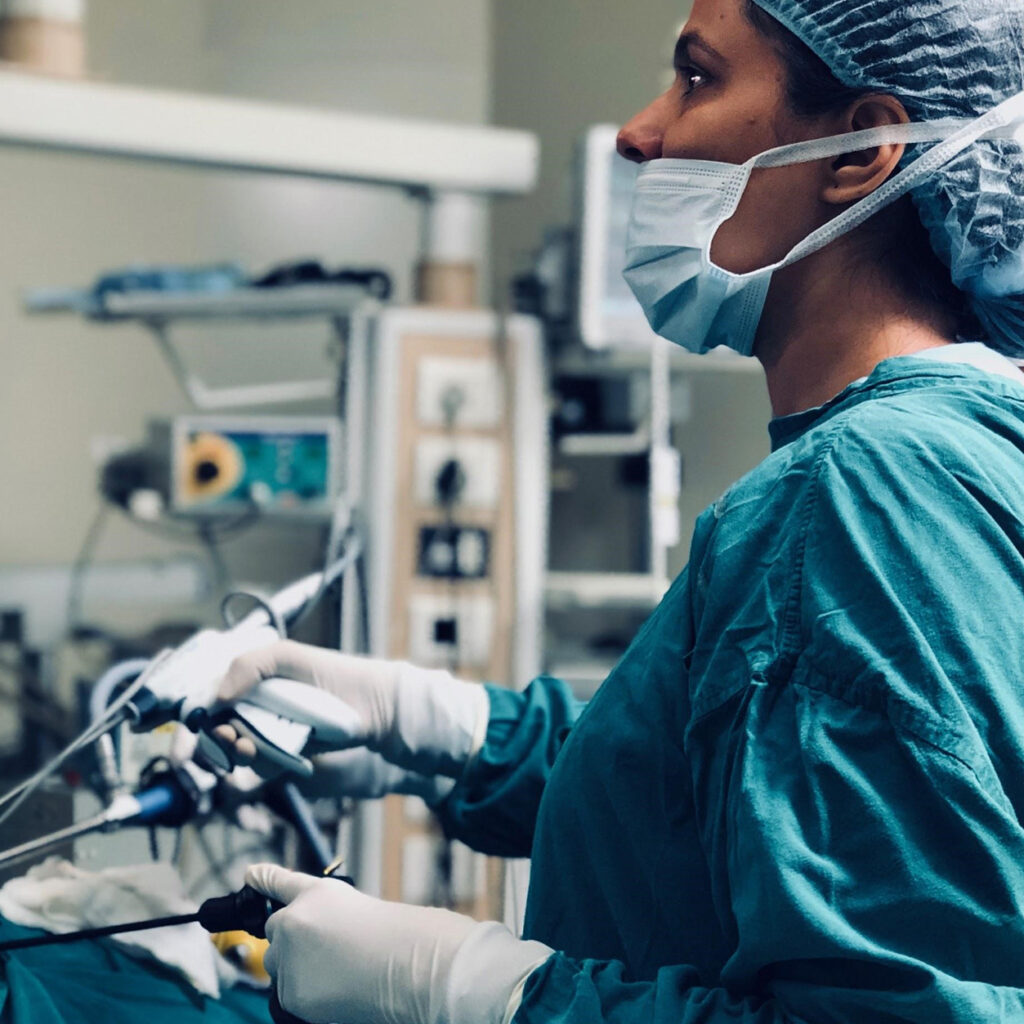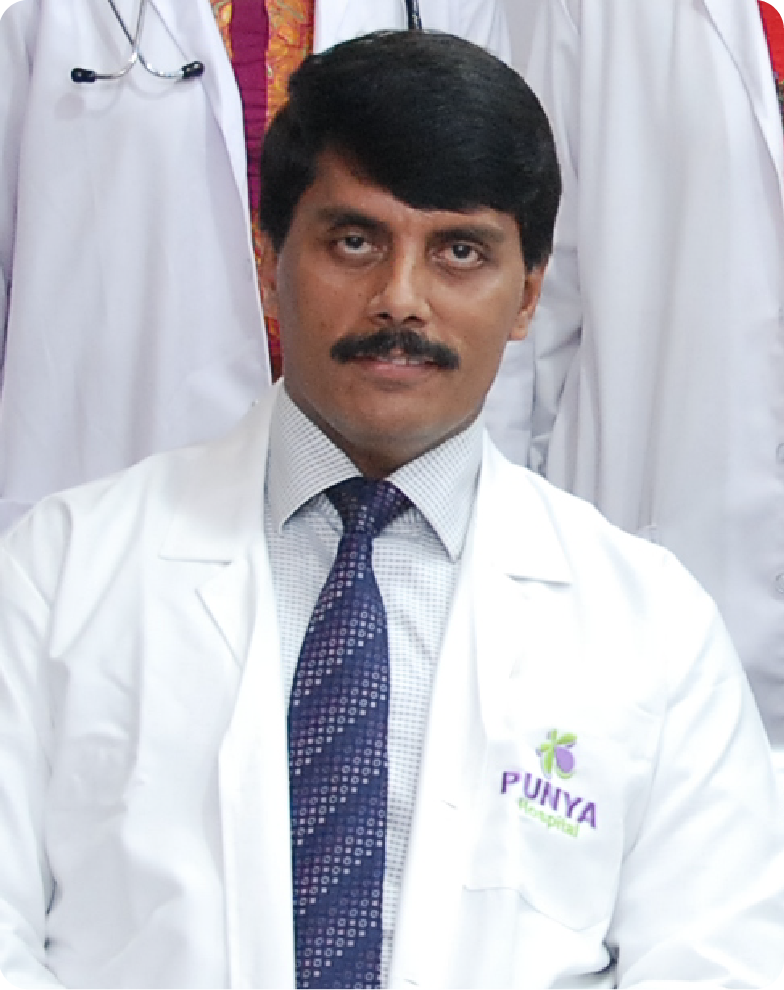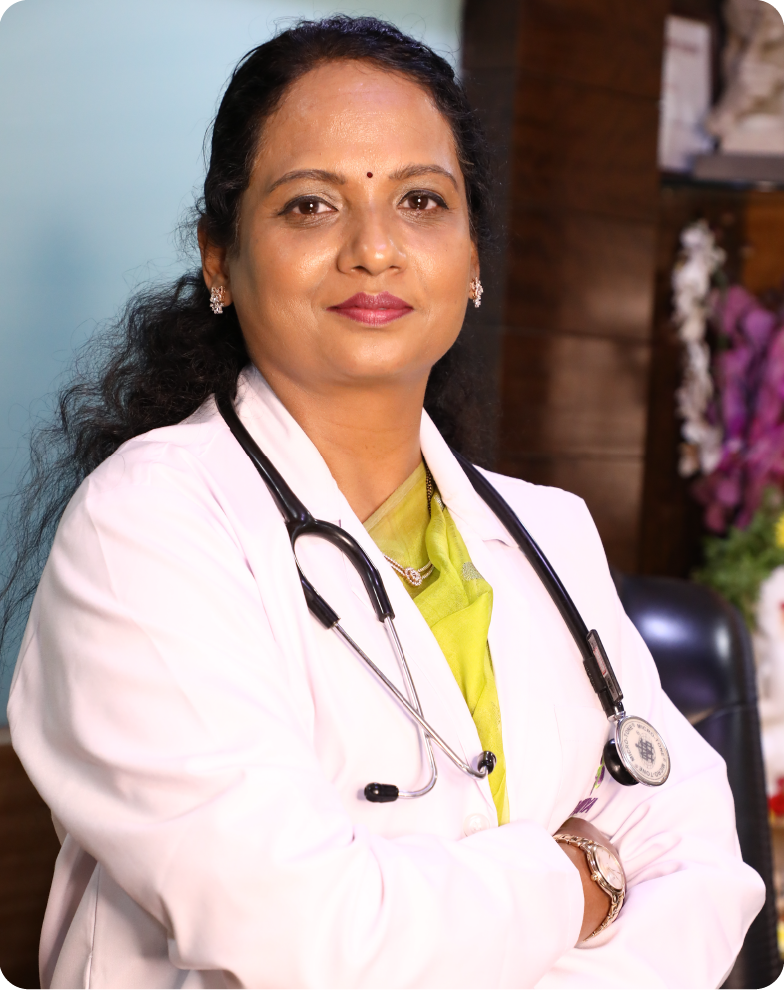Gynec Laparoscopy Surgery
Gynec Laparoscopy Surgery
Dr.Punyavathi C. Nagaraj, Consultant Laparoscopic Gynaecologist in our institute, and also has keen interests in laparoscopic radical hysterectomy, laparoscopic sling surgeries, and laparoscopic myomectomy.
The surgeons and staff at the General & Laparoscopic Surgical Center of Punya Hospital, Bangalore are committed to provide the best surgical care using their skills combined with the latest techniques and technologies in minimally invasive – as well as traditional – surgery.
As Surgical Associates of Punya Hospital, Karnataka our surgeons and Laparoscopic Gynaecologist are highly trained in the safe, effective use of the laparoscopic technique.

During a laparoscopic procedure, several small incisions are made in the area to be treated. Carbon dioxide gas is passed into the abdominal cavity in order to move the abdominal wall away from the organs and therefore create a larger area in which to work.
Through one of the incisions, the surgeon then inserts a laparoscope. This is a tiny camera that projects the images it records onto a large monitor, allowing the surgeon to see inside of the body without having to make a long incision.
The advantages of laparoscopy surgery are numerous and include the following:
- Less Post-Operative Discomfort.
- Faster Recovery.
- Smaller, more discrete Scars.
- Reduced Risk of Complications.
Laparoscopic And Endoscopic Gynec And Infertility Procedures
Gynecology is that branch of medical science which specializes in the health of women in relation to her genital system. Women’s genital system is comprised of reproductive organs which includes the uterus where the fetus grows, the cervix which is the opening of the uterus to the vagina, the ovaries which produce the sex hormones and eggs, the fallopian tubes which carry the egg from ovaries to the uterus and the vagina which is a muscular tract from the cervix to the outside of the body.
Diagnostic Laparoscopy
Tubal Patency Test
Inability to conceive a child experienced by a couple even after living together and trying for the same is considered as infertility. One of the major causes for this condition is the block in the fallopian tubes. If the tube is completely blocked the sperm will not able to reach the egg and fertilize it. But in cases of partial block the sperm may reach the egg and fertilization may take place. But it is possible that the embryo may not reach the uterus and may be trapped inside the fallopian tube. This is a dangerous condition known as ectopic pregnancy.
Tubal Reconstruction
Fallopian tubes are tubular passages that connect endometrium in the uterine cavity to peritoneal cavity. After ovulation the ovum is captured by fallopian tubes and serves as a passage for its journey to the uterus. Fertilization of the egg by the sperm takes place in the fallopian tube. The embryo so developed continues its travel to the uterine cavity through the fallopian tubes. In the uterine cavity the embryo gets implanted in the endometrium. Ovum and the embryo is not having any intrinsic mobility. Fallopian tube functions as a passage and transporter of the ovum and the embryo. Fallopian tube also helps the sperm to travel to the spot of fertilization. Thus the existence of fallopian tubes is a prerequisite for normal pregnancy in a woman. Functions of fallopian tube can be disrupted by various infections and diseases which may end up in infertility and in severe cases it may lead to sterility also. Reconstruction of fallopian tube is the traditional treatment option for fallopian tube problems.
Fimbrioplasty
Fimbrioplasty is a reconstructive procedure used to correct problems in the fallopian tube. Fimbrioplasty has the advantage that it takes care to preserve and release the delicate fimbariae, which is very important in making pregnancy possible. This surgery is usually conducted only after making a comprehensive study about the infertility problem faced by the couple under investigation
PCOD drilling
Poly cystic ovary syndrome (PCOS) is situation in women resulting from hormone imbalance which may lead to non ovulation and consequent infertility. Women who are having poly cystic ovary syndrome can be made ovulating by following a surgical procedure known as laparoscopic ovarian drilling. In this procedure laser beams or electrocautery is used to smash parts of ovaries. This surgical procedure is not generally used. But for women who are not ovulating in spite of undergoing medication for infertility and after losing weight, this surgery has been found to be extremely useful.
Adhesiolysis
Scar tissue formed consequent to surgeries or that are formed between organs are known as adhesions. About 90 % of patients who undergo abdominal surgeries have been reported to develop adhesions. They are normally asymptotic and do not pose any threat to the life of the patients concerned. There are possibilities that adhesions may cause severe bowel problems.
Laparoscopic Treatments
Endometriosis
Lining inside the uterus is medically referred as endometrium. Endometrium thickens during the follicular phase of the menstrual cycle. If conception occurs endometrium under goes decidualization. The fetus derives nutrients and oxygen form the endometrium. If conception does not occur endometrium breaks down and is passed out through menstruation.
Total Laparoscopic Hysterectomy
Total laparoscopic hysterectomy is the surgical procedure used to remove a woman’s uterus. Conditions like fibroids in uterus, cancer of uterus, ovaries, cervix, uterine prolapsed, and endometriosis, pelvic pain, vaginal bleeding etc are some of the causes which necessitate the removal of uterus.
Lap Radical Hysterectomy
Endometrial cancer is the abnormal growth of cells in the lining of the uterus. Removal of uterus as a result of cancer is medically referred as hysterectomy. When the uterus, fallopian tubes, ovaries and cervix are removed, it is known as total hysterectomy. When only the uterus and two third portion of the vagina are removed in a surgical procedure, that procedure is known as radical hysterectomy.
Laparoscopic Surgeries On Ovaries
A pair of ovaries located on both sides of uterus are most important organs of the human body which produces eggs for the reproduction purpose. But the ovaries can be dysfunctional due to the existence of cysts, polyps, tumors etc. There a lot of treatment options for the successful management of this disorders. Even though medications have been found to be very affective in controlling and relieving the symptoms, the eradication of the disease or disorder is usually accomplished by surgical removal of the affected ovary or ovaries and the adjacent structures like fallopian tubes uterus etc.
Ovarian Cyst Removal
Fluid filled sacs inside or on the ovaries are known as ovarian cysts. Women have a pair ovaries located on both sides of the uterus. Ovaries, which have the size and shape of almonds, produce eggs and are released during the menstrual cycle. Women are likely to have some ovarian cysts during their life.
Submucosal Fibroid Removal
Non cancerous growths in the uterus that develop on the muscular tissues are known as fibroids. Fibroid growing on the outer surface of the uterus is refereed by the medical term submucosal fibroids. The sub mucosal fibroids usually develop a under the lining of the uterus. Though they are not very common, they are considered to be the most dangerous type of fibroids as they cause heavy bleeding.
Endometrial Ablation
Endometrial ablation is the process used to destroy the endometrium or the lining of the uterus. This procedure is generally used for treating the abnormal uterine bleeding. This procedure is done using a hysteroscope which is an instrument with a light and a camera so that the inner part of the uterus can be viewed by the surgeon with the help of the hysteroscope.
Adhesion Removal
Scar tissue formed consequent to surgeries or that are formed between organs are known as adhesions. About 90 % of patients who undergo abdominal surgeries have been reported to develop adhesions. They are normally asymptotic and do not pose any threat to the life of the patients concerned. There are possibilities that adhesions may cause severe bowel problems.
OUR TEAM

Dr. Nagaraj B Puttaswamy
Senior Consultant - Laparoscopic Surgeon Bariatric Surgeon and Surgical Gastroenterologist

Dr. Punyavathi C Nagaraj
Senior Consultant- Gynaecologist and Laparoscopic Surgeon


